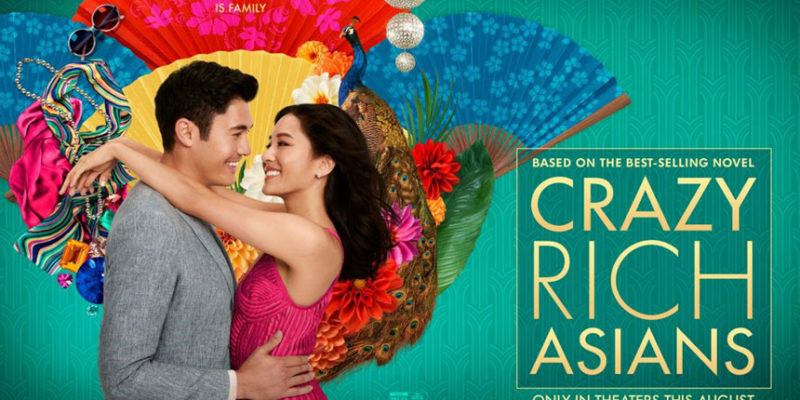A triumph for Hollywood, a triumph for Asian Americans: A review of “Crazy Rich Asians”
Kaylyn LingOct 09, 2018

Picture courtesy of Center for Asian American Media, Warner Bros. Entertainment Inc.
You’re sitting in a crowded movie theater when the screen goes dark. The toe-tapping hits of a big band begins to play. As images begin arising for the movie’s opening credits, so do the croons of a smooth jazz vocalist. It’s exactly what you’d expect to hear in an avant-garde NYC jazz club — until you realize that the entire song is performed in fluent Mandarin Chinese.
All eyes are on “Crazy Rich Asians” because of its unabashed desire to give Western audiences a culture shock.
“Crazy Rich Asians” is the summer blockbuster that’s storming Hollywood headlines. It’s being lauded for its recognition of the Asian American community in its inclusive casting. The Jon M. Chu-directed film opened on August 15 and raised over $35 million during its five-day opening weekend — a major accomplishment for any film, especially one of the rom-com genre. Based off Kevin Kwan’s 2013 novel of the same name, “Crazy Rich Asians” follows New York University professor Rachel Chu and her blossoming romance with Singaporean bachelor Nicholas Young. Most of “Crazy Rich Asians” focuses on Chu’s struggle to prove herself to Young’s ultra-wealthy family in Asia, but the film’s buzz doesn’t concern the romantic story line. All eyes are on “Crazy Rich Asians” because of its unabashed desire to give Western audiences a culture shock.
Kwan, upon writing the original novel, said that he had a mission “to introduce a contemporary Asia to a North American audience.” If the film’s success is any indication, Kwan met his goal. The movie orbits around a universe of Asian splendor that is all but unknown to the American public. “Crazy Rich Asians” peels back the curtain on this splendor through encounters with the Young family, one of the wealthiest families in Singapore. Chu, representing the common American perspective, finds herself alienated by Young’s family and friends because she lacks status and wealth to back her name. The movie’s on-location set in Singapore and Malaysia gives viewers exactly what they’d expect: hawker food stalls, crowded streets and boisterous lunch dates. Shortly after, however, the film envelops audiences in scenes of surreal wealth. Houses built to emulate palaces and closets fit for a runway model fill the silver screen in a Gatsby-esque fashion. The contrast of these two settings intentionally subverts the Western expectation of Asia.
The movie orbits around a universe of Asian splendor that is all but unknown to the American public.
After the film’s initial show-and-tell of Singaporean luxury, “Crazy Rich Asians” seems to confirm its self-aware desire for culture shock with a well-timed quip in a dinner table scene where Ken Jeong’s character Goh Wye Mun says, “Think of all the starving children in America!”
The extravagant shows of wealth are not the only things that make this film unique. More than anything, “Crazy Rich Asians” is recognized for its cast. For the first time in 25 years, Hollywood has produced a movie with an all-Asian cast, following in the footsteps of another landmark book-turned-movie “The Joy Luck Club.” The cast includes several familiar faces, among which Constance Wu, Ken Jeong and Awkwafina light up the screen with genuine performances and good chemistry.
Like the cast, the soundtrack to “Crazy Rich Asians” embraces Asian representation. There are many Chinese-English bilingual songs, including a sparkling rendition of Madonna’s “Material Girl” and a swinging “Wo Yao Ni De Ai”, which is a cover of American jazz classic “I Want Your Love – I Want You to Be My Baby.” Thirteen out of the 14 tracks are credited to musicians of Asian heritage. Having Asian representation in its direction, cast and soundtrack makes “Crazy Rich Asians a triple threat and is more than enough to draw attention in the modern box office.
However, with all of that said, not all is well in the world of “Crazy Rich Asians.” Select critics have pointed out a discomforting truth: despite the movie’s slogan of diversity, there is little to no recognition for Singapore’s minority Malay and Indian populations. This overlooking of ethnic minorities is insensitive to those familiar with a real-world Singaporean discrimination issue.
Having Asian representation in its direction, cast and soundtrack makes “Crazy Rich Asians a triple threat and is more than enough to draw attention in the modern box office.
Possible reason for criticism does not end there. “Crazy Rich Asians” focuses so much on the glitz and glamour of its production that it feels shallow at points. For example, many of the scenes between Chu and Eleanor Young, the matriarch of the family, have a fascinating tension characterized by fake smiles and coded dialogue, but that tension is never fully realized. It fizzles without a satisfying climax. Similarly, side plots ebb and flow throughout the movie, falling just short of exciting, emotional or relatable; select parts of the film teeter on the side of boring. One such secondary plot is the story of Astrid Young, Nicholas’s glamorous cousin, finding out that her husband Michael is having an affair — despite its potential as a fascinating foil to the Chu-Young romance, the development of Michael and Astrid’s relationship is so rushed that the reveal lacks real impact.
In disheartening honesty, those looking for a more engaging, action-packed film may not be satisfied with “Crazy Rich Asians,” but viewers interested in a light-hearted Asian Cinderella story will be enthralled.






